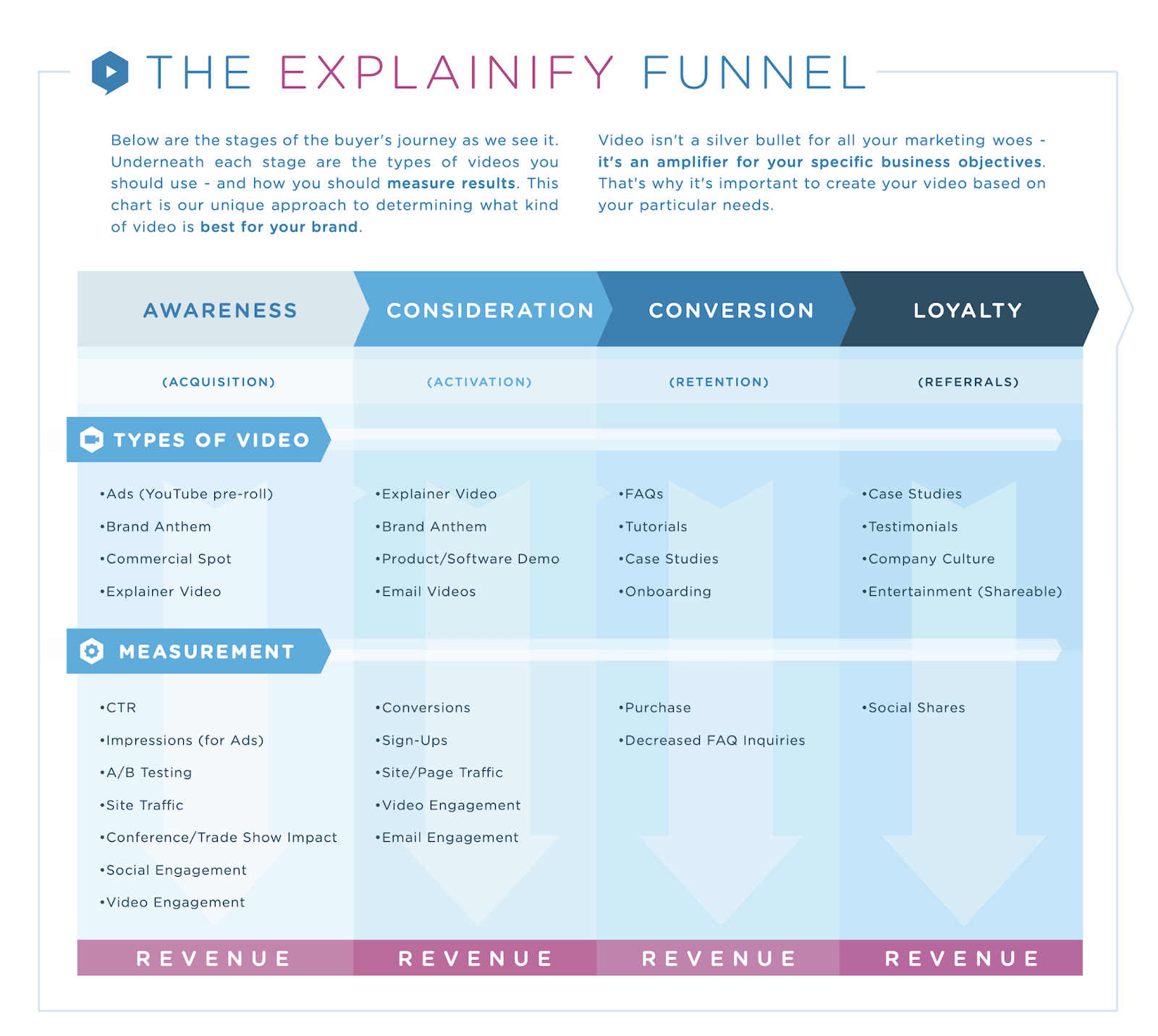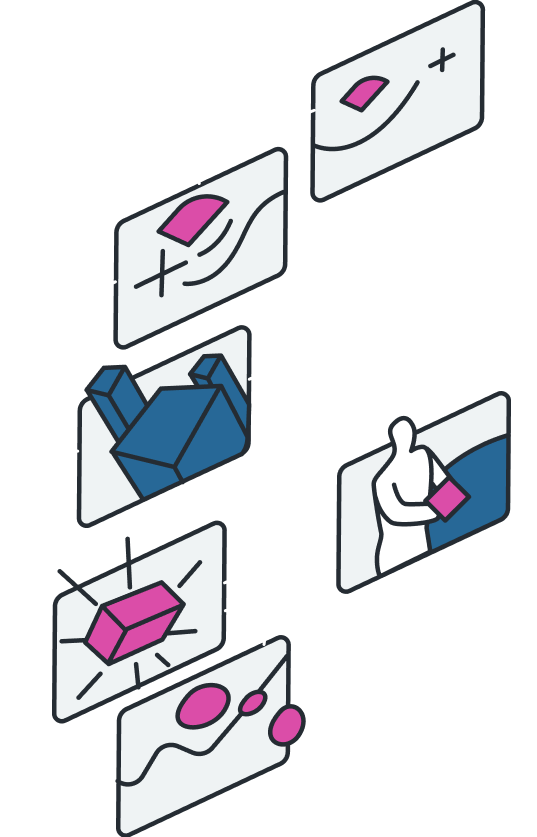Now, more than ever, with so many products and services vying for consumers’ attention, the process of making a sale is an actual process—a multi-step, involved operation that one marketing video simply can’t cover.
That’s to say: you need more than one video in your marketing strategy, and every video you create needs to be able to speak to a specific stage in the buyer’s journey.
To do this, you need to know your product or service intimately and know what you can bring to the table for prospective customers. You also need to anticipate what those customers need during every step of the customer buying journey they take when they engage with your marketing campaign. Equipped with this knowledge, you’ll be able to deliver the best videos possible during every step of the buyer’s stages, all hopefully resulting in a new customer at the end of the journey.
That’s where Explainify comes in. We’re going to simplify things because we know it can be a little bit intimidating at first.
In this article, we’ll not only explore just what a buyer’s journey is, but we’ll also outline different types of videos, and explain what makes them so great for each step of the buyer stages. By the end of this article, you’ll have the confidence to be able to put together an incredible multi-step, multi-video marketing package that can guide consumers through the buyer’s journey stages and convert them to reliable customers.
Let’s get started!
What is the Buyer’s Journey?
he buyer’s journey is a multi-step process that consumers (hopefully your future customers) go on when they make a purchase. The buyer’s journey stages start when a prospective customer comes to realize they have a problem. The next step is then researching their problem and weighing out the different solutions available to them on the market to fix the problem. After that, they consider all of their options, and finally, they buy a product or utilize a service to solve their problem, and their journey is complete.

It may seem easier and more cost-efficient to simply create a catch-all marketing video and hope for the best rather than focusing upon each of the buyer’s journey stages individually and crafting a marketing video for each of those pivotal stages. But in the long run, that initial investment of creating multiple videos, or even simply a stages video to reflect the multiple stages in the buyer’s journey will end up doing you a world of good. You’ll find that you have a much higher conversion rate because you catered to every step of their buying journey.
Remember your job as a marketer is to make sure your brand or product is present during every step of that journey, to anticipate what consumers need, and to guide them along that journey. If you guide them well, you won’t have a problem converting them to buyers, and possibly repeat customers if you’ve done your job well.
The best way to ensure you’re doing your job right is by using the right type of video for each step.
Why You Need Video in Your Buyer’s Journey
You might be wondering why it’s so important to use video in your marketing campaign. That’s because a video-first strategy ensures your content is engaging, dynamic, shareable, and easily consumed compared to traditional print media and old-school text-based campaigns.
When it comes to the power of video marketing, the stats don’t lie:
-
- 54% of people want to see more video content from marketers, according to a 2020 study. (Source: HubSpot)
- Also, in 2019, video was the number one form of media used in content strategy, overtaking blogs, and infographics. (Source: 2020 State of Marketing)
The Perfect Type of Video to Use for Every Step of a Buyer’s Journey
Let’s go through each of the buyer’s journey stages step-by-step, and investigate which kind of video works best for each step.

The Awareness Phase
This is the start of your buyer’s journey—your prospective customer has identified the problem that they have, and might have started researching to solve that problem. In fact, they may not even be thinking about solving the problem. They’re just aware that they have a problem. They’re weighing the importance of the issue, and at this point, potentially buying something may not even have crossed their mind.
As such, at this stage of the customer buying journey, you don’t need to pull out all of the big guns and go in for the proverbial kill. In fact, you don’t need to do anything more than simply make prospective customers aware of your existence and introduce yourself to them.
This is where an animated brand video can do wonders for you.
Think of it like this: an animated brand video acts as a short primer for your brand, telling prospective customers what makes you unique, and giving them some insight into your brand story—maybe through a brief history of the brand or by showcasing what makes you unique.
This isn’t so much about selling a product outright, but about sharing your brand with people. This helps ensure that as a customer moves onto the next step in their buyer stages, they’re not only aware of your brand, but they’re actively thinking about it.
A great brand video introduces—or possibly re-introduces people if you’re relaunching a brand—to your prospective customers by telling them the story of your brand. It humanizes the brand. The thing to remember is that this isn’t about sales, it’s about awareness: you’re meeting them where they are in their buyer’s journey. It’s important to get people thinking about you and to start making your brand or product well-known. When they think of a certain problem they have, if you’ve created an effective brand video, your brand ought to be the first one that pops into their head.
Using an animated brand video can go a long way when it comes to introducing yourself, as animated videos have proven to be effective, engaging, and visually appealing ways to catch your audience’s eye.
The Consideration Phase
This is the second of the buyer’s journey stages, and at this point, customers have already figured out what their problem is. Now, they want to do something about it, and it’s up to you to help provide solutions to how they could solve those problems.
One of the best ways to do this is by using an animated explainer video. Explainer videos are fantastic because they take a complex idea or sets ideas and distill them into an easily digestible, short video that clearly explains what your brand and your product are all about. It gets the message out about your product as quickly, and easily, as possible, and often does so in a fun, dynamic way. Sometimes these explainer videos can take on a life of their own and have a chance to become viral.
Several different types of explainer videos exist, and you can use a combination of any of these:
-
-
- Whiteboard animation: This type is great to give your explainer videos a sense of really educating an audience.
- Motion graphics or motion typography: This technique can help spice up information that may otherwise come off as a bit dry and dull.
- Animated cartoon videos: Using cartoons can be a great way to invigorate a commercial with life, whimsy, and fun. You could also use these cartoons as a way to launch a mascot that becomes synonymous with your brand.
-
Once you’ve used an explainer video to share the messaging behind your product, you’re not quite done with the consideration phase of the buyer’s journey.
Now it’s time to really showcase what your product can do with a product video. A great product video demonstrates exactly how your product stands out from others and convinces customers that your product is the one true solution to their problem.
Product videos can often feature real-life footage, especially if it makes sense for your product, but don’t be afraid to get creative and with animated videos. You can take a completely animated approach if your product is digital, for example. Or maybe you’ve already established a fun cartoon mascot in your previous explainer video, or possibly even at the end of your brand video. Why not continue your brand story by having your cartoon mascot feature in your product video too?
For example, let’s say you’re demonstrating an app: you’ll want to show on-screen footage of how your app actually works, but don’t be afraid to spice it up with some animation.
You can also use product videos to serve the role of demonstration videos. Not only are product videos great to explain how your product can be a great solution to a problem, but don’t be afraid to create videos that demonstrate how your products work. The fewer questions prospective buyers have about your products, the better.
Sales videos are another type of animated video that can help push your product to the next level and guarantee a sale. These types of videos are very similar to product videos, and brand videos—they highlight what makes your company so unique, and what makes it stand out from the crowd.
Closing the Deal: Conversion and Loyalty
It’s the last of the buyer’s journey stages: the decision-making stage. Will the potential customer buy your product? If you’ve done your job well, and your multi-step approach and stages video campaign knocks it out of the park, they will!
At this point, your potential customer is staring down the proverbial finish line, and 90% committed to your product. Don’t get overconfident: you could very easily lose them in that final 10% if you’re not careful.
In a perfect world, you’ve done all you can do and they’re committed, but you also know that many other brands are vying for their attention, and they’re considering other solutions just as much as, or maybe even possibly more than, yours.
Realistically, you’ve done the bulk of what you can do. It doesn’t hurt, of course, to hit them again with another brand video that focuses on your brand’s story and explores the human side of your brand: what makes your brand, your origin story, or your product so unique. Do you have a special employee story that everyone can relate to? Amazing—tell it!
Consider using a PR video during this phase as well, because it can be more than about just selling a product. PR videos can do an amazing job of connecting your customers to your brand or products and helping to build up trust.
Take a look at this Nike ad.
This is essentially a PR video for Nike—note that it doesn’t sell anything. What it does is connect the company with its audience, and lets them know that Nike stands for something. It also lets people know that sports unite us and that Nike is a massive part of sports. It doesn’t explicitly sell a product but it drives home a message that Nike wants its audience to hear. PR videos can be a great way to drive home a message, and driving home a message can be a great way to get your brand, and your product, to the top of someone’s mind.
PR videos can also take the form of testimonials from customers or experts, which can be one final boost to help persuade potential customers that, yes, your product is the way to go. You can use animation to help breathe life into quotes from customers and experts alike. Those testimonials can also be added to product videos to help verify the authority behind your sales pitch.
The Deal is Closed: What Now?
It’s all over now, and luckily for you, you’ve got a new customer! Your job isn’t quite done yet. The customer buying journey doesn’t end after they’ve bought a product and moved on. You want to ensure brand loyalty, and you can do that with a few simple steps throughout your marketing campaign.
-
-
- Call-to-Action: When you’re ending your videos, don’t forget a call-to-action. Engage with your potential customers and have them not only just digest your video, but interact with it. Encourage them to share it on social media and be a part of a conversation. Use hashtags, get them to tell their stories, and so on. Don’t make it all about a product. Make them feel as though they’re part of an ongoing discussion and a community.
- Make a Follow-Up Video: It’s not just about the sale, but it’s about gratitude as well. After you’ve made your sale, don’t be afraid to make a marketing video that engages with your customers and thanks them for their ongoing support. Again: they’ll feel like part of a community, and they won’t simply feel like a number. This can do wonders to help drive brand loyalty.
-
To recap: the customer buying journey has three distinct stages: awareness,/consideration, conversion/loyalty.
-
-
- During the awareness phase, your customers are aware of the fact that they have a problem and need to be made aware of your brand with brand videos.
- During the consideration phase, they’re considering how to solve their problem, and a combination of explainer videos, product videos, and sales videos can help sway them to purchase your products.
- Finally, in the actual conversion phase, they’ll make the purchase, and you can use PR videos and testimonials to help push customers over the line to seal the deal. From there, it’s then about guaranteeing customer loyalty.
-
Hopefully, after having read this article, you’ll have learned a bit about choosing the best kind of video for each stage of your customer buying journey. It can seem like a lot to take on creating so many different videos, but that’s where Explainify has your back.
When you’re ready to get started on your marketing campaign, get in touch with us and we’ll help you put together a great video campaign for each and every step of your buyer’s journey.



